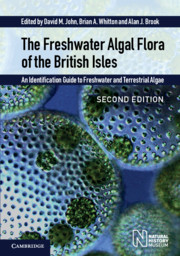 The Freshwater Algal Flora of the British Isles
The Freshwater Algal Flora of the British Isles Published online by Cambridge University Press: 12 January 2024
Most species of Haptophyta (also known as Prymnesiophyta) are single-celled flagellates, but some may have amoeboid, coccoid, palmelloid or filamentous stages. The flagellate cells have usually two flagella of equal or subequal length (unequal in the order Pavlovales), both of which are smooth. In most members of the Pavlovales the forward one is covered with small knob-like scales and fine non-tubular hairs that are invisible in the light microscope; tubular flagellar hairs as in the Chrysophyta or other heterokont flagellates do not exist in the Haptophyta. The two flagella may have a similar action (homodynamic) or move differently (heterodynamic). Between them there is a characteristic additional appendage, the haptonema. Depending on the species, this organelle is long, thread-like, exceeding the cell in length, or shorter, bulbous, or vestigial. It consists of 6 or 7 microtubules enclosed in two or three sheathing membranes (not visible with light microscopy). Haptonemata are capable of bending and flickering and, if long, can coil rapidly and uncoil slowly in response to shock. Haptonemata do not play a role in locomotion, but may be used in prey capture or anchoring the cell. The 1–2(–4) chloroplasts are usually golden or yellow-brown, because accessory photosynthetic pigments mask the green of the chlorophyll (chlorophylls a, c1/c2 and sometimes c3). The surface of the cell is covered with minute scales or granules of organic composition (not visible in light microscope) and, in addition, there may be calcified scales (coccoliths) visible in the light microscope; species with such scales are called coccolithophorids.
The Haptophyta comprises at present some 80 genera and 300 species; a large number of additional genera and species of fossil coccolithophorids have been described. Especially common in marine waters are species of Chrysochromulina, Phaeocystis and coccolithophorids (e.g. Emiliania huxleyi). Only about a dozen haptophyte species are known from freshwater or terrestrial habitats. Five have been recorded from the British Isles.
To save this book to your Kindle, first ensure [email protected] is added to your Approved Personal Document E-mail List under your Personal Document Settings on the Manage Your Content and Devices page of your Amazon account. Then enter the ‘name’ part of your Kindle email address below. Find out more about saving to your Kindle.
Note you can select to save to either the @free.kindle.com or @kindle.com variations. ‘@free.kindle.com’ emails are free but can only be saved to your device when it is connected to wi-fi. ‘@kindle.com’ emails can be delivered even when you are not connected to wi-fi, but note that service fees apply.
Find out more about the Kindle Personal Document Service.
To save content items to your account, please confirm that you agree to abide by our usage policies. If this is the first time you use this feature, you will be asked to authorise Cambridge Core to connect with your account. Find out more about saving content to Dropbox.
To save content items to your account, please confirm that you agree to abide by our usage policies. If this is the first time you use this feature, you will be asked to authorise Cambridge Core to connect with your account. Find out more about saving content to Google Drive.